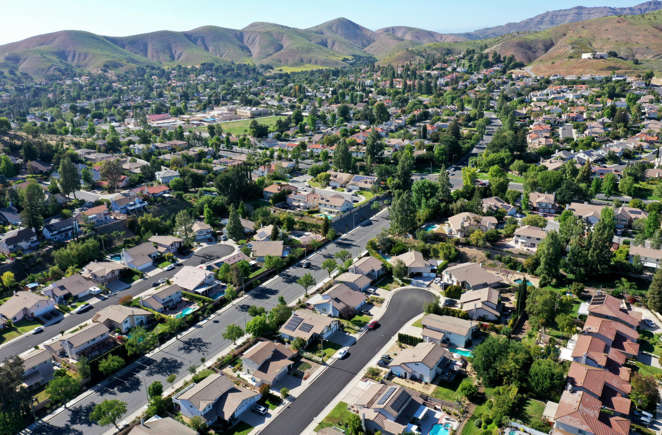The land of the free, the home of the brave, the melting pot, the land of opportunity… You name it, the US claims to offer it. This has made it a nation where many want to build a life. Chasing the American dream can be enticing, but before you take the final plunge, it’s important to consider both the pros and cons of life in the United States. While the US boasts world-class universities and has a comparatively strong economy, let’s not forget the challenges it faces. Is the US the right place for you? Click through to find out. Pros of living in the US©Shutterstock
There are numerous pros, or upsides, to living in the US, from the economy to the vibrant cultural hubs.
1. Strong economy
The US economy is comparatively strong. In fact, in the first quarter of 2024, the US gross domestic product (GDP) increased at an annual rate of 1.4%. Additionally, the year-over-year inflation, or the rate at which consumer prices increase, was down 6% in 2023 and the unemployment rate at the end of 2023 was 0.3% lower than at the beginning of the year.
2. Diverse nature
From white sandy beaches to snow-capped mountain tops and everywhere in between, the US boasts diverse nature options. According to surveys, Massachusetts, Washington, and Maryland have some of the top natural environments in the country.
3. Air traffic system©Shutterstock
The air traffic system in the US means that you can conveniently travel from most major cities both domestically and internationally. This is especially helpful for those who work abroad or have family in other parts of the country.
4. Low taxation©Shutterstock
US taxes are low, relative to those in other high-income countries. In 2023, the US was near the bottom of the list with a 29.9% tax burden compared to an OECD average of 34.8%. The countries with the highest taxes were Belgium, Germany, and France.
5. Low fuel costs©Shutterstock
Americans also enjoy lower fuel costs. The average national price for gas is US$3.449 per gallon which is down from US$3.578 a year ago. It’s important to note though that prices fluctuate greatly depending on where in the US you are. For example, prices in the Western states are about 20% higher than the national average. In California, they’re about 50 percent higher.
6. Strong currency©Shutterstock
The US Dollar is actually the world’s reserve currency and has continued to demonstrate strength. The dollar is used globally to buy and sell goods between countries that may not have the same currency, like South Korea and Brazil for example.
7. Generous housing sizes©Shutterstock
Houses in the US are often extremely large. In fact, the average home size in the United States is 2,426 square feet (225 square meters)! For comparison, the average house size in France is 1,206 square feet (112 square meters), and just 818 square feet (76 square meters) in the United Kingdom.
8. Diversity
The US is known as the “melting pot,” and in certain areas, there is a lot of racial diversity. While diversity doesn’t necessarily mean equality, it is a positive factor in the US overall.
9. Pop culture
A great deal of the pop culture produced by the United States is enjoyed globally. The US has superstar artists like Taylor Swift, blockbuster movies like ‘Barbie’ (2023), and so much more to share.Cons of living in the US©Shutterstock
While there are many great aspects of living in the US, unfortunately, there are also many downsides. Click through to explore the 16 negative aspects of life in America.
1. Healthcare
Unfortunately, the average American doesn’t have access to affordable healthcare in the United States. In fact, Americans spend an average of US$12,555 each year on their health which is double the global average. It’s a staggering statistic. Additionally, pharmaceutical companies have a big influence on doctors and prescription prices.
2. Poverty
Extreme poverty is another downside of life in America as the federally mandated minimum wage is only US$7.25 per hour. Though the US has lower taxes and fuel costs, the rate of pay hasn’t risen anywhere near as much as the prices of homes, fuel, groceries, and electricity.
3. Employee rights
Workers and employees in the US don’t have many rights and unions are looked down upon. Losing your job is quite easy in the US and what hangs over Americans’ heads the most is that it can be actually harder to find a job after losing one. Also, the unemployment benefits in the US are often lower in amount and shorter in length when compared to other wealthy countries.
4. Paid time off
A whopping 28 million Americans don’t get any paid vacation or paid holidays! This lack of work-life balance can cause long-term damage to your mental and physical health. Americans who do get paid vacation are only allowed 11 days on average per year. People need time to relax and enjoy their lives, but the US thinks otherwise.
5. Parental leave
Only 17% of companies offer paid parental leave, and of those, the best programs offer only 12 weeks at 67% of the normal pay. Most countries similar to the US offer a minimum of two months of paid leave for both parents.
6. Gun violence
In the United States, the Republican and Democratic parties hold opposing views on stricter gun control laws. Meanwhile, gun-related homicides in the US are 22 times higher than in Europe. In 2024 alone, 499 shootings were reported, highlighting the persistent tragedy of gun violence with no clear end in sight.
7. Social progress
The United States has seen a steep decline in social progress over the last few years in particular. Between declining personal rights and increased maternal mortality rates since the overturning of Roe v. Wade, the US is falling behind. There’s also an overall lack of inclusivity, nutritional knowledge, affordable housing, and health and wellness resources.
8. Education costs
Coming in at nearly twice what most countries pay for university, in America, a four-year degree will set you back nearly US$37,650. Many students are forced to take out expensive loans with high interest rates. For years following their graduation, American students are crippled by debt.
9. Transit system
In the US, public transit falls behind other wealthy countries. There has been an emphasis on cars and the expansion of the national highway system in the US resulting in more fossil fuel emissions and worse congestion. Even though cities like New York or Washington D.C. have public transportation systems, they don’t keep up with the likes of Paris, London, or Beijing.
10. Life expectancy
Life expectancy in the US is currently sitting at 79.25 years old which is lower than in comparable countries. There are experts who attribute this reduced life expectancy in the US to the terrible healthcare system and Roe v. Wade being overturned, contributing to higher maternal mortality
11. Standard of living
Quality of life is measured by purchasing power, safety, healthcare, cost of living, property price to income ratio, pollution, climate, and commute time. Compared to other similar countries, the United States falls short. One study even found that an individual in the US needs a salary of US$96,500 per year to be comfortable living in a major US city. Meanwhile, the median salary in the US is less than US$60,000.
12. Climate change
The US is the world’s second-largest greenhouse gas emitter. Americans need to stop deforestation and add more fuel-efficient means of transportation (amongst other things) to their agendas, or the world will continue to suffer.
13. Internet speed
The US has slower internet speeds than other countries, including Hong Kong, Chile, Singapore, and Iceland. Additionally, it is estimated that about 14.5 million Americans don’t have internet speeds that reach the 25 Mbps standard for broadband speed. This is particularly prevalent in rural towns across the US.
14. Obesity
The US is the worldwide leader in obese citizens and a lot of that can be attributed to the abundance of fried foods, fast food restaurants, and the availability of questionable ingredients that are often banned in other countries.
15. Imperial measurement system
In the US, the imperial measurement system is used while the rest of the world uses the metric system. In schools, some students are taught the metric system, or how to convert to it, but the standard is the imperial system. This makes conversions more timely and presents a greater risk of error.
16. Political divisiveness
The political divisiveness in the US is striking. Even if you don’t consider yourself a political person, you will be impacted. For example, in states like Florida, there have been book bans and even the removal of psychology coursework from high schools, amongst many other things. There is a huge division of values in the US which leaves minority groups in danger.
FAQ: Is America a safe country
While the US can be safe for some, it can be challenging and dangerous for others. Many minority groups including women, people of color, and those in the LGBTQ communities may have tougher lives in the US.
FAQ: Is America a good place to raise kids?
While the USA can be a good place to raise children, the high cost of childcare coupled with a poor work-life balance creates problems for many. This doesn’t mean you can’t raise children here, but it might be difficult and expensive.
: Is America a good place to meet new people?©Shutterstock
In the US, it’s definitely possible to meet friends and a partner. Of course, some places are more friendly and open than others, but in general, it’s certainly possible to build a community in the United States.










